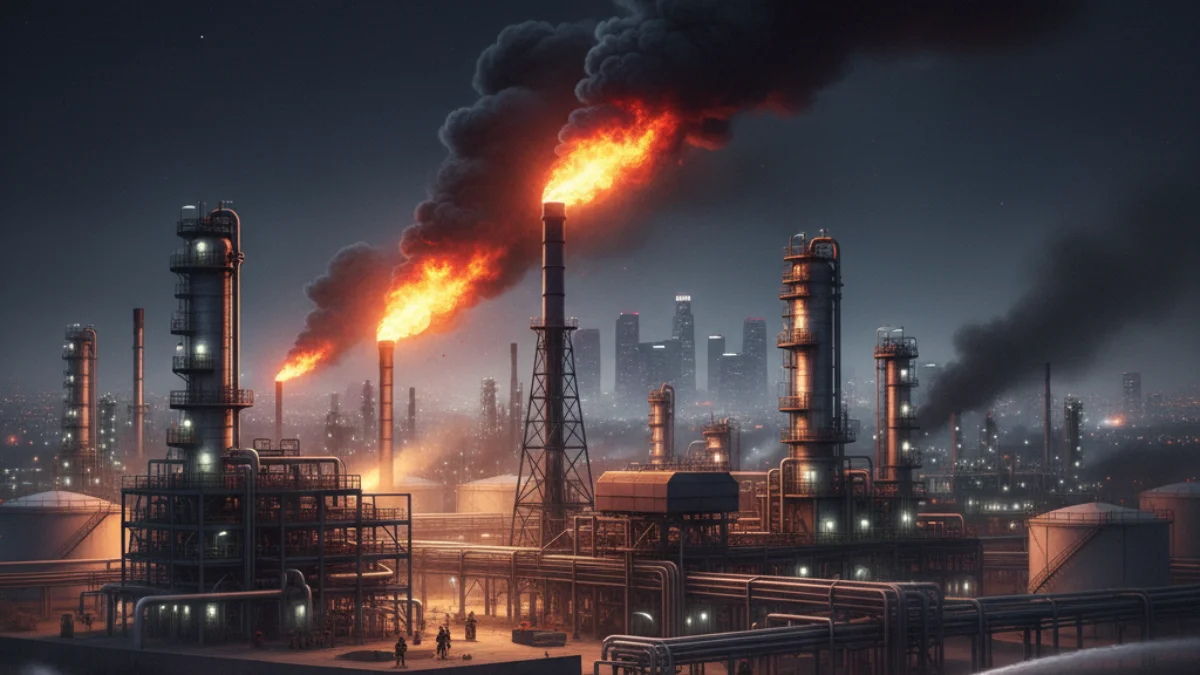Shortly after 9:30 PM on October 2, flames shot into the night sky above El Segundo as a powerful Chevron refinery fire broke out in one section of the massive facility. Residents as far as Manhattan Beach reported hearing a loud rumble, describing it as a blast. The fire comes at a delicate time for the plant, which was already undergoing a phased restart after earlier unit shutdowns.
This report tracks the Chevron El Segundo refinery fire: what is confirmed so far, its potential hazards, and the broader implications for California’s energy infrastructure.
The Incident: What We Know
- The fire started around 9:30 PM, visible across the South Bay and near LAX.
- Emergency flaring was immediately activated to control internal pressure.
- Officials confirm no injuries or evacuation orders at this stage.
- The refinery’s daily processing capacity is 290,000 barrels, making it one of the largest oil hubs on the West Coast.
- Investigations into the cause are underway, involving Chevron, Los Angeles Fire Department, and state regulators.
One witness said the explosion felt like a shockwave. A youth soccer match in El Segundo was abandoned after spectators saw smoke and flames rising over the industrial zone.
Safety and Operational Risks
Even if the fire is contained, risks remain significant:
- Combustion of hydrocarbons may release toxic air pollutants such as sulfur dioxide and VOCs.
- Prolonged exposure to flames can damage pipelines, tanks, and structural components.
- If fire spreads, the potential for chain reactions in storage tanks could escalate.
Chevron’s internal firefighting team moved quickly, supported by Los Angeles emergency units. State agencies are monitoring air quality to assess health risks for nearby communities.
The refinery had been in partial restart earlier this year. A disruption of this scale could stall its recovery timeline, affect regional supply, and possibly lead to temporary price pressures at California pumps.
Expert Views and Policy Context
Energy analysts argue that such incidents highlight the fragile balance between industrial output and public safety. Deferred maintenance, aging equipment, and operational stress are recurring factors in refinery accidents worldwide.
State regulators are expected to examine maintenance records, safety audits, and emission filings. In recent years, California has tightened oversight of oil operations while simultaneously pushing for a transition toward clean energy.
The incident also ties into a broader conversation about energy security. The United States recently expanded efforts to diversify critical resources, including investment in Canadian lithium mining, a move meant to reduce reliance on unstable supply chains. Read more here.
Just as cross-border energy strategy matters, so too does international stability. Local industrial crises often echo larger geopolitical tensions, such as the Sir Creek dispute between India and Pakistan, where questions of sovereignty intersect with resource management. Explore that analysis here.
What Comes Next
Key developments to watch:
- Results of the investigation into the fire’s origin.
- Timeline for restarting affected units or repairing damaged infrastructure.
- Air quality monitoring and community health advisories.
- Possible enforcement action by state and federal regulators.
- Impact on fuel prices if supply disruption persists.
Chevron has pledged cooperation with authorities and assured the public that the situation is under control. For now, containment appears to be holding, but trust in the safety of aging energy infrastructure will be harder to restore.
Conclusion
The Chevron refinery fire in El Segundo is more than an industrial accident. It raises difficult questions about infrastructure resilience, oversight, and the cost of proximity between heavy industry and dense urban life. Early reports suggest limited damage and no casualties, yet the symbolic effect is striking. A flash of fire over Los Angeles underscores both the vulnerability of regional energy supply and the urgent push for safer, cleaner alternatives.
Frequently Asked Questions
Q: Was anyone injured in the Chevron refinery El Segundo fire? No injuries have been reported so far. Officials say the fire was contained to one section.
Q: What is the refinery’s capacity? It processes about 290,000 barrels of crude oil per day, one of the largest outputs in California.
Q: Did the fire affect Los Angeles International Airport (LAX)? Authorities confirmed no impact on LAX operations.
Q: Will this fire raise gas prices in Los Angeles? If the disruption is brief, the impact should be minimal. A prolonged shutdown, however, could tighten supplies and raise prices.
Q: What will investigators focus on? Likely points of focus include equipment failure, safety protocols, and regulatory compliance.

